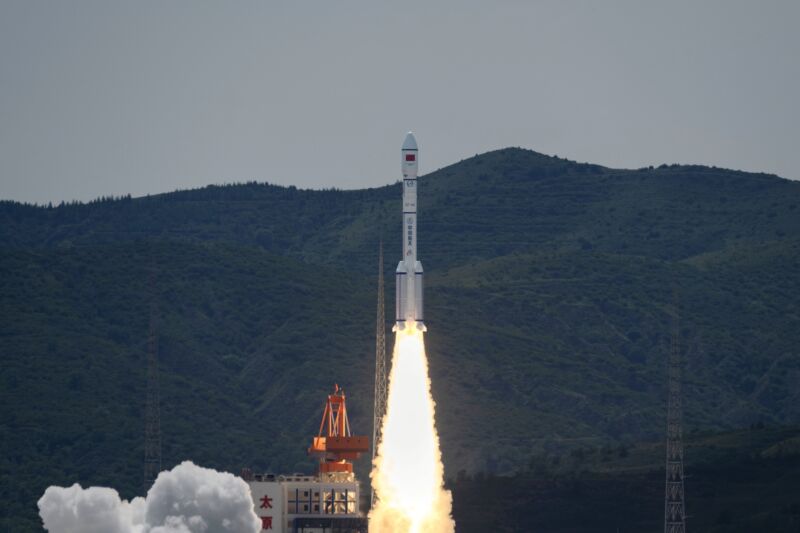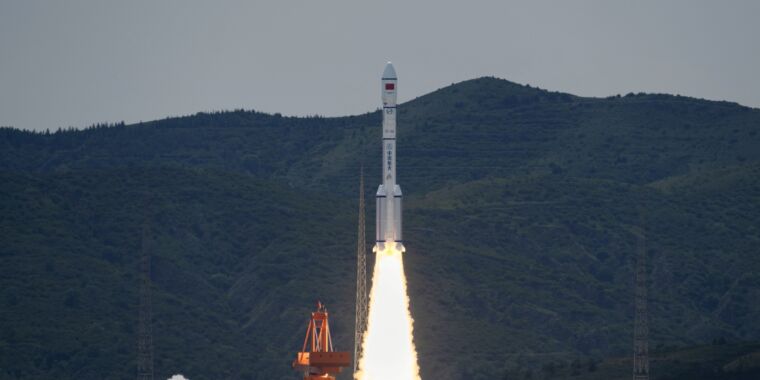
Chinese officials have long indicated that they are interested in building a satellite network, or perhaps several, to beam broadband internet signals to China and other countries within their sphere of influence.
There are two serious efforts underway in China to develop a rival to SpaceX’s Starlink network, which the Chinese government has banned on its soil. The first batch of 18 satellites for one of those Chinese networks were launched into low Earth orbit on Tuesday.
A Long March 6A rocket carried the 18 spacecraft into a polar orbit after launching at 2:42 a.m. EDT (06:42 UTC) from the Taiyuan Launch Complex in northern China's Shanxi Province. The Long March 6A is one of China's newest rockets, and the country's first to use strap-on solid rocket boosters, with the ability to launch a payload of up to 4.5 metric tons (9,900 pounds) into a 700-kilometer (435-mile) sun-synchronous orbit.
According to the China Aerospace Science and Technology Corporation, the largest state contractor for China's space program, the rocket delivered its payload of 18 Qianfan satellites into the correct orbit around Earth and the launch mission was a complete success.
Qianfan means “Thousand Sails,” and the 18 satellites launched Tuesday are the first of potentially thousands of spacecraft planned by Shanghai Spacecom Satellite Technology (SSST), a company backed by the Shanghai municipal government. The network developed by SSST is also called the “Spacesail Constellation.”
Shanghai officials only began releasing details about the constellation last year. A filing with the International Telecommunication Union suggests that developers of the Shanghai-based mega-constellation initially plan to place 1,296 satellites at an altitude of about 1,160 kilometers (721 miles).
Xinhua, China's state news agency, said the network “will provide global users with satellite broadband Internet services with low latency, high speed and highly reliable quality.”
Open the floodgates?
SSST's network was previously known as G60 Starlink, a reference to a major highway in China and the project's goal to mimic SpaceX's broadband service.
Thousand Sails could eventually consist of more than 14,000 satellites, but like other internet mega-constellations, the size of the fleet will likely grow at a pace that matches demand. It will be many years before SSST can deploy a constellation of 14,000 satellites, if it ever does. SpaceX has deployed several generations of Starlink satellites to provide new services and increased capacity to meet customer demand.
Chinese officials have released few details about the Qianfan satellites. But the project's backers have said the spacecraft has a “standardized and modular” flat-panel design. “It meets the needs of stacking multiple satellites with one rocket,” according to Shanghai Gesi Aerospace Technology, a joint venture set up by SSST and the Chinese Academy of Sciences to oversee production of the Qianfan satellites.
This is very similar to the design of SpaceX’s Starlink satellites, which are flat-packed for launch on Falcon 9 rockets. SpaceX pioneered this method of launching and deploying large numbers of satellites. The approach used for Starlink, and apparently for Qianfan as well, streamlines the integration of multiple satellites with their launch vehicles on the ground. It also simplifies their separation from the rocket once they are in orbit.
The new Qianfan satellite factory in Shanghai can produce up to 300 spacecraft a year, project officials said in December. Officials previously said the first 108 satellites for the Thousand Sails constellation would be launched this year.
SSST announced in February that it had raised more than $900 million from Chinese state-backed investment funds, the Shanghai municipal government and venture capital sources. SSST’s origins are linked to a Chinese joint venture with a Germany-based company called KLEO Connect, which planned to develop a smaller constellation of low-Earth orbit satellites for data relay services.
China launched four technology demonstration satellites, reportedly related to the KLEO Connect venture, to test telecom hardware and electric propulsion systems in space. The joint venture fell apart amid a flurry of lawsuits, and the German government last year blocked a full takeover of KLEO Connect by its Chinese investors.
Now SSST is going it alone with the Thousand Sails network. It has rapidly scaled up satellite production capacity in Shanghai. But outside of Starlink, companies with mega-constellation ideas have faced serious headwinds.
OneWeb filed for bankruptcy in 2020 before finally launching its full first-generation network of 633 internet satellites. Amazon has delayed the large-scale deployment of its Project Kuiper megaconstellation, and the launch of the first operational Kuiper internet satellites could be delayed again until 2025. The future of the European Union’s IRIS² satellite internet network is in doubt after disagreements between European governments over the project’s funding.
The Thousand Sails constellation is less well-known than another planned Chinese satellite internet network, known as Guowang, or “national network,” which is backed by the Chinese central government. Guowang is owned by a state-backed company called SatNet, and its architecture will consist of 13,000 satellites. China has yet to launch a spacecraft for the Guowang project, however.
It is unclear whether the Thousand Sails network and the Guowang constellation will be direct competitors. They could be aimed at different segments of the broadband market. In both cases, China's restrictive internet policies with terrestrial networks will likely spill over into the satellite segment.
Chinese officials recognize the military utility of satellite internet services like Starlink, which have supported Ukrainian forces in their fight against Russian troops since 2022. A Starlink-like service of its own would undoubtedly be useful to the Chinese military.
In addition to potential domestic citizen users, China could use its satellite internet networks as a diplomatic tool to build on existing partnerships between the Chinese government and developing countries. This could lead to “a leapfrog transition, with African countries choosing the Chinese internet constellation over Western providers because much of their infrastructure is already built by China,” the Royal United Services Institute, a British think tank, wrote in a report last year.
While questions remain about how China will use its satellite mega-constellations, it is true that deploying them will require a significant increase in the country’s launch capacity. This will spur the development of new commercial rockets, including reusable boosters, to reduce costs and increase flight speed.

